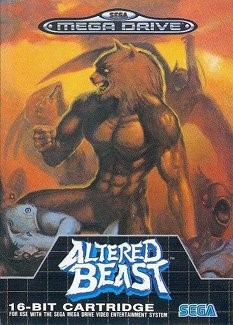
Altered Beast debuted in the arcades in 1988 using Sega's System 16 board, which was then noted for its state-of-the-art scaling effects. While the game made limited use of this hardware, it proved a hit with enough players to guarantee it an after life as a home conversion. For those unfamiliar with the game, you are cast as a centurion resurrected to rescue Zeus's daughter, Athena from the evil clutches of Neff (as a powerful deity in her own right, quite why she needs rescuing is never explained). There follows five levels of beastie bashing and zombie slaying. Perhaps an early attract was how the undead exploded into chunks of flesh after getting a battering. Nice. As you move along you acquire power ups from killing a blue Cerberus, transforming your character into an ever-more buff killing machine. When three are scooped up you change into a beastie of your own - two different kinds of fireball-toting werewolf, a flying dragon with electrical attacks, a were-bear who can turn opponents into stone, and a were-tiger with a singularly rubbish energy ball that dances up and down the screen. For his part, Neff throws legions of ghouls and monsters your way, as well as depositing the end of each level with a compulsory boss fight.
And that's all there is to it. A simple thump-a-thon with a Greek mythology theme and interesting power up mechanic appealed to the punters, so how could the home conversions go so horribly wrong? But they did. Commodore's Amiga, the most advanced micro of the time, had this abomination served up. Sega's own conversion to the Master System was pretty awful too. And yet, perversely this worked to Sega's advantage. Altered Beast on the MegaDrive is by far the closest of all the conversions produced for the 8- and 16-bit markets, and plays well too. It's nowhere near as difficult as the arcade parent, and is a nut so soft even the most cack-handed of gamers could crack it with enough practice. Such low difficulty helped generate demand for a new gaming experience - one could not dine out on Altered Beast for long. Importantly, it set a new standard for video games by being almost arcade perfect. For whatever reason, this was much harder to achieve on the likes of the Amiga and Atari ST and so, side-by-side, the MegaDrive version blew them out of the water - even though pound for pound it wasn't as advanced as Commodore's machine in a number of areas. It was a teaser as well, the gaming equivalent of flirty fishing. Well not mind-blowing by the standards of the date, the whole package was carried off with enough aplomb - big sprites, smooth scrolling, parallax, clear speech (which was seldom achieved in later MegaDrive games, bizarrely) to hint at the potential snuggled up in the system's hardware.
Altered Beast's big problem, however, was its strength. As a simplistic title video game evolution very quickly outpaced it. Within a year of its release it looked tired and a wee bit drab. It became the butt of console mags, with buyer's guide scores ranging from the average to the distinctly dire. Small wonder Sega eventually dropped it for the much more impressive Sonic the Hedgehog - a title that remains a peak achievement of 16-bit programming and game design. Yet it served its purpose. Altered Beast accelerated the take up of the (then) new generation of consoles, cleaving and converting Nintendo adherents in North America and throwing down an insurmountable challenge to the home computer formats in Western Europe. It was the shape of things to come and helped establish the 'arcade experience' as the key hegemonic game playing value where late 80s/early 90s gaming was concerned. So if you ever pick upon a review, whether from the time or more recently that heaps criticism on Altered Beast, just pity the fools: it had a profound, if understated impact on gaming.
No comments:
Post a Comment